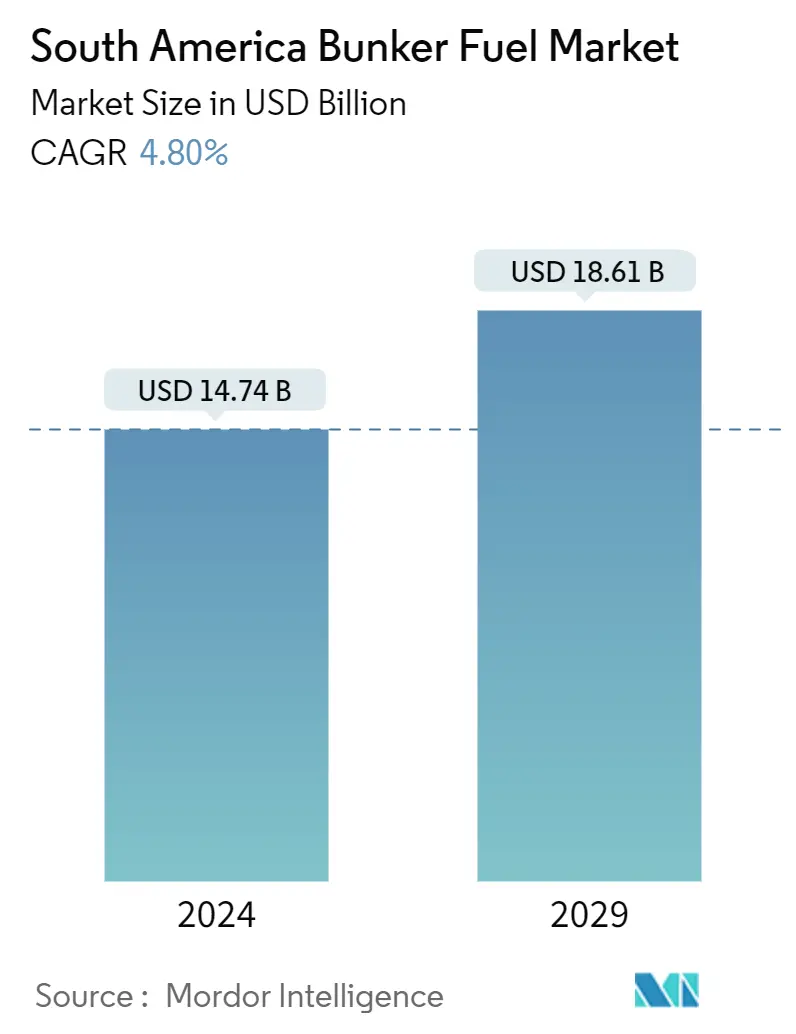Market Size of South America Bunker Fuel Industry

| Study Period | 2020-2029 |
| Base Year For Estimation | 2023 |
| Market Size (2024) | USD 14.74 Billion |
| Market Size (2029) | USD 18.61 Billion |
| CAGR (2024 - 2029) | 4.80 % |
| Market Concentration | High |
Major Players
*Disclaimer: Major Players sorted in no particular order |
South America Bunker Fuel Market Analysis
The South America Bunker Fuel Market size is estimated at USD 14.74 billion in 2024, and is expected to reach USD 18.61 billion by 2029, growing at a CAGR of 4.80% during the forecast period (2024-2029).
- Over the medium term, factors such as the ever-rising marine transportation of essential commodities and implementation of stricter environmental regulations driving the demand for cleaner bunker fuels drive the growth in the South American bunker fuel market.
- On the other hand, the oil market’s volatility is significantly expected to affect the bunker fuel market as it can impact the profitability of bunker fuel suppliers and make planning and investing difficult.
- Nevertheless, the increase in the use of clean bunker fuels creates a significant opportunity for the South American bunker fuel market.
- Brazil is expected to dominate the bunker fuel market in the region owing to factors like substantial crude oil production and a steady rise in exports from the country.
South America Bunker Fuel Industry Segmentation
Bunker fuel is a type of liquid fuel that is fractionally distilled from crude oil. The bunker fuel, often referred to as fuel oil, can be classified according to its chemical make-up, intended use, and boiling point.
The South American bunker fuel market is segmented by Fuel Type, Vessel Type, and Geography. By fuel type, the market is segmented into High Sulfur Fuel Oil (HSFO), Very Low Sulfur Fuel Oil (VLSFO), Marine Gas Oil (MGO), Liquefied Natural Gas (LNG), and Other Fuel Types (Methanol, LPG, Biodiesel)), by vessel type the market is segmented as Containers, Tankers, General Cargo, Bulk Container, and Other Vessel Types. The report also covers the market size and forecasts for South America Bunker Fuel across the major countries. For each segment, the market sizing and forecasts have been done based on revenue (USD).
| Fuel Type | |
| High Sulfur Fuel Oil (HSFO) | |
| Very Low Sulfur Fuel Oil (VLSFO) | |
| Marine Gas Oil (MGO) | |
| Liquefied Natural Gas (LNG) | |
| Other Fuel Types (Methanol, LPG, and Biodiesel) |
| Vessel Type | |
| Containers | |
| Tankers | |
| General Cargo | |
| Bulk Container | |
| Other Vessel Types |
| Geography | |
| Brazil | |
| Chile | |
| Argentina | |
| Rest of South America |
South America Bunker Fuel Market Size Summary
The South American bunker fuel market is poised for growth, driven by the increasing demand for marine transportation and the implementation of stricter environmental regulations that favor cleaner bunker fuels. Brazil is expected to lead the market due to its substantial crude oil production and rising exports, which are bolstered by the country's strategic location and role as a major oil exporter. The market's expansion is also supported by the growing number of vessels operating in the region and the demand for Very Low Sulfur Fuel Oil (VLSFO), which has risen significantly following international mandates to reduce sulfur emissions from ships. Despite the challenges posed by oil market volatility, the shift towards cleaner fuels presents a significant opportunity for market players.
The South American bunker fuel market is characterized by a semi-fragmented landscape with key players such as Bunker Holding A/S, Monjasa Holding A/S, and World Fuel Services Corp. Brazil's dominance in the region is further reinforced by its large recoverable ultra-deep oil reserves and the increasing maritime trade activities that necessitate a reliable supply of bunker fuel. Initiatives like the partnership between Kanfer Shipping AS and Nimofast Brasil S.A. to establish LNG bunkering solutions highlight the region's commitment to expanding its marine fuel infrastructure. Additionally, developments such as Petrobras' renewable content bunker delivery and Trinidad and Tobago's LNG hub project underscore the broader trend towards sustainable energy solutions in the maritime sector.
South America Bunker Fuel Market Size - Table of Contents
-
1. MARKET OVERVIEW
-
1.1 Introduction
-
1.2 Market Size and Demand Forecast in USD, till 2029
-
1.3 Recent Trends and Developments
-
1.4 Government Policies and Regulations
-
1.5 Market Dynamics
-
1.5.1 Drivers
-
1.5.1.1 Rising Marine Transportation of Essential Commodities in South America
-
1.5.1.2 Supportive Policies for Cleaner Bunker Fuel
-
-
1.5.2 Restraints
-
1.5.2.1 Volatile Nature of Oil Market
-
-
-
1.6 Supply Chain Analysis
-
1.7 Porter's Five Forces Analysis
-
1.7.1 Bargaining Power of Suppliers
-
1.7.2 Bargaining Power of Consumers
-
1.7.3 Threat of New Entrants
-
1.7.4 Threat of Substitutes Products and Services
-
1.7.5 Intensity of Competitive Rivalry
-
-
-
2. MARKET SEGMENTATION
-
2.1 Fuel Type
-
2.1.1 High Sulfur Fuel Oil (HSFO)
-
2.1.2 Very Low Sulfur Fuel Oil (VLSFO)
-
2.1.3 Marine Gas Oil (MGO)
-
2.1.4 Liquefied Natural Gas (LNG)
-
2.1.5 Other Fuel Types (Methanol, LPG, and Biodiesel)
-
-
2.2 Vessel Type
-
2.2.1 Containers
-
2.2.2 Tankers
-
2.2.3 General Cargo
-
2.2.4 Bulk Container
-
2.2.5 Other Vessel Types
-
-
2.3 Geography
-
2.3.1 Brazil
-
2.3.2 Chile
-
2.3.3 Argentina
-
2.3.4 Rest of South America
-
-
South America Bunker Fuel Market Size FAQs
How big is the South America Bunker Fuel Market?
The South America Bunker Fuel Market size is expected to reach USD 14.74 billion in 2024 and grow at a CAGR of 4.80% to reach USD 18.61 billion by 2029.
What is the current South America Bunker Fuel Market size?
In 2024, the South America Bunker Fuel Market size is expected to reach USD 14.74 billion.

